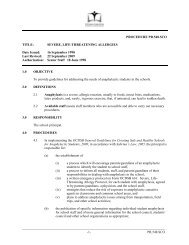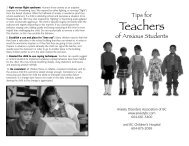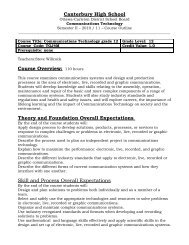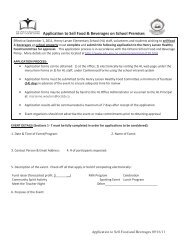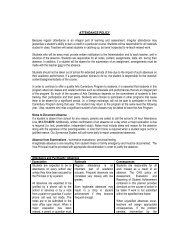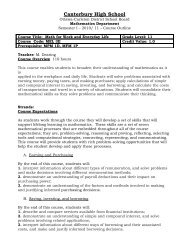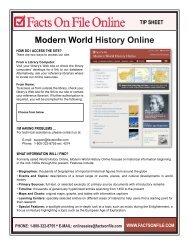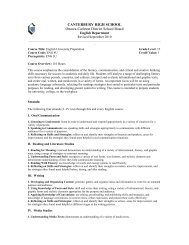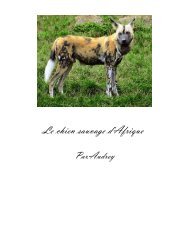Grade 10 Exploring Integrated Technologies, TIJ1O - Canterbury ...
Grade 10 Exploring Integrated Technologies, TIJ1O - Canterbury ...
Grade 10 Exploring Integrated Technologies, TIJ1O - Canterbury ...
You also want an ePaper? Increase the reach of your titles
YUMPU automatically turns print PDFs into web optimized ePapers that Google loves.
<strong>Canterbury</strong> High School<br />
Ottawa-Carleton District School Board<br />
Technological Studies<br />
Semester II – 20<strong>10</strong> / 11 – Course Outline<br />
__________________________________________________________________________________<br />
Course Title: <strong>Exploring</strong> <strong>Integrated</strong> <strong>Technologies</strong> <strong>Grade</strong> Level: 9<br />
Course Code: TIJ<strong>10</strong> Credit Value: 1.0<br />
Prerequisite: Open<br />
Teachers: Mr. David Andrews , Michael Dearing<br />
Course Overview: 1<strong>10</strong> hours<br />
<strong>Exploring</strong> <strong>Integrated</strong> <strong>Technologies</strong>, <strong>Grade</strong> 9, Open (TIJ<strong>10</strong>)<br />
This course enables students to understand the technological and computer concepts they will need in<br />
order to design, develop, and build usable products or to deliver services, as well as to pursue further<br />
technological studies. Students will use the technological design process and a variety of tools and<br />
software to solve problems, complete projects, and strengthen their communication skills.<br />
Strands:<br />
Theory and Foundation<br />
By the end of this course, students will:<br />
• Demonstrate understanding of how to develop products or provide services to meet identified<br />
needs;<br />
• Identify ways to communicate design and research ideas and solutions through a variety of<br />
media;<br />
• Demonstrate understanding of how to evaluate project work in relation to identified<br />
specifications, using quality control procedures;<br />
• Describe the scope of activities supporting by computer and information technology;<br />
• Explain the fundamentals concepts underlying the creation of a computer program.<br />
Skill and Process<br />
By the end of the course, students will:<br />
• Fabricate products or deliver services using a design process and a variety of tools and<br />
equipment;<br />
• Share information locally and globally using communication tools such as email;<br />
• Use a variety of software application for research, to solve problems, and to document the<br />
design process;<br />
• Identify products techniques and materials to meet design specifications;<br />
• Use correctly problem solving model, such as the scientific method or design making model,<br />
completing all the required steps.<br />
Impact and Consequences<br />
By the end of the course, students will:<br />
• Apply safety standards when using materials, tools, and equipment;<br />
• Describe the environmental effects of materials, processes, and resources;<br />
• Demonstrate understanding of how developments in technologies influence people’s lives;<br />
• Identify technology – based careers and their educational requirements.
Units of Study:<br />
Unit Titles<br />
Unit One Technology & Society & Drafting 22 hours<br />
Unit Two Transportation: Mousetrap vehicle 22 hours<br />
Unit Three Construction and Technological Design: Dream House 22 hours<br />
Unit Four Focus on Manufacturing: Bird Feeder 22 hours<br />
Unit Five Design Focus: Locker Organizer 22 hours<br />
Unit Organization<br />
Unit 1: Technology, Society & Drafting<br />
Time: 22 hours<br />
Description<br />
This unit introduces students to the social and cultural implications of new technology; we also<br />
consider the role of women in technology and the morel and ethical implications of developing new<br />
technologies. We do a history of technological revolutions and consider the role of customer services.<br />
In this unit students six plain figure drawings, three sets of orthographic drawings, and study<br />
the conventions for dimensioning non- cylindrical objects. We draw one and two point perspective<br />
drawings, and students design a safety poster.<br />
Unit 2: Transportation: mousetrap vehicle<br />
Time: 22 hours<br />
Description<br />
The projects in this module introduces many aspects of transportation technology including vehicle propulsion<br />
aerodynamics design and drive rations. Students will design and produces a vehicle that is propelled by a<br />
mousetrap. Students will create sketches, dimension drawings, top front side drawings, they will construct and<br />
assemble the vehicle components, evaluate vehicle specifications and write a performances report.<br />
Unit 3: Construction and Technological Design: Dream House<br />
Time: 22 hours<br />
Description<br />
What is your dream home like Is it large and roomy or small and cozy Is it in the country side or the heart of<br />
the city The challenge is to research and design a home that is attractive comfortable and fictional. In this<br />
process students learn basic measuring skills sketching drawing, how to make a sale model safety procedures for<br />
working in a technical facility. Students also learn to brain storm and communicate design ideas and identify<br />
standard sizes of common architectural elements, and the basic use of universal architectural symbols.<br />
Unit 4: Focus on Manufacturing: Bird Feeder<br />
Time: 22 hours<br />
Description<br />
When you wake up in the morning did you ever consider that each and every item that you can see and touch<br />
has been designed, engineered and manufactured for your use In this unit you will discover the world of<br />
manufacturing, and create useful objects from a verity of materials. You will discover with manufacturing the
possibilities are endless. In this unit you will design and manufacture an innovative stylish and efficient bird<br />
feeder that will discourage pests, rodents, and predators. You will learn to document the steps in the design<br />
process, produces a technical report and a portfolio.<br />
Unit 5: Design Focus: locker Organizer<br />
Time: 22 hours<br />
Description<br />
This unit challenges students to apply all that they have previously learned about the design process, use of tools<br />
and equipment, as well as safety. In this project you will design and build an efficient storage organizer for a<br />
typical school locker. Your locker organizer must incorporate three different types of materials.<br />
Teaching/Learning Strategies<br />
The fundamental approach for teaching and learning is by providing a real-world, hands-on, project basis to the<br />
course in each unit. This course incorporates a variety of teaching/learning strategies, including student- and<br />
teacher-directed activities, individual learning activities, group work, and co-operative learning. The teacher<br />
should provide students at the beginning of each unit with the information, resources, and guidance necessary to<br />
complete each task safely and with maximum opportunity for success. Teachers provide students with<br />
opportunities to work both independently and in groups to perform the following tasks: problem solving,<br />
brainstorming, safely using hand and power tools, following various design processes, collecting information,<br />
report writing, assessing and evaluating projects, and making classroom presentations.<br />
Assessment/Evaluation Techniques<br />
Methods of assessment and evaluation include a wide variety of approaches to enhance the learning<br />
environment. Assessment methods may include: performance assessments such as project deliverables and skill<br />
demonstrations; personal communication assessment such as instructional questions and answers, conferences,<br />
classroom discussions, journals, or log books; and standardized tests such as classroom tests or examinations.<br />
Self- and peer assessment assist the student by providing directions to improve performance. Assessment charts<br />
included in each activity provide the basis for teacher evaluation rubrics, student self-assessment, or team<br />
assessment tools.<br />
Final summative assessment and evaluation should take the form of a research and presentation task that allows<br />
students to demonstrate their knowledge and understanding of the design process. Unit 5 includes activities that<br />
can be used as the summative task for evaluation purposes. The summative task may be supplemented by<br />
summative evaluation in the form of a test or exam.<br />
Evaluation Summary:<br />
Term 1: 35%<br />
Term 2: 35%<br />
Summative project: 30%<br />
Total : <strong>10</strong>0%



